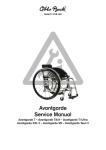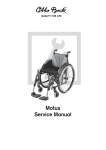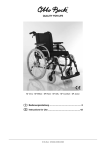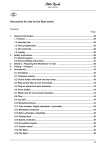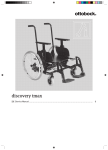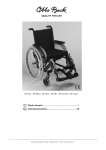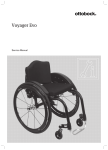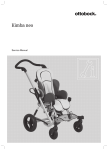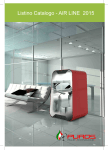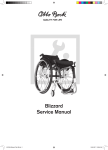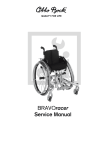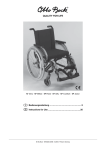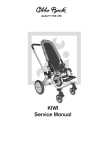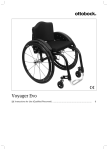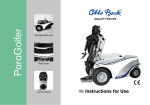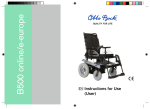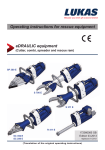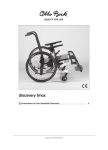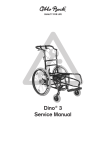Download Start Series - Ottobockdoc.se
Transcript
Start Series M1 Intro • M2 Effect • M3 Hemi • M4 XXL • M5 Comfort • M6 Junior Service Manual Contents Service Manual for the Start 3 Series Contents Page 1 Introduction.......................................................................................................................5 1.1 Preface�������������������������������������������������������������������������������������������������������������������� 5 1.2 Technical Support�������������������������������������������������������������������������������������������������� 5 1.3 Information for Service Staff...................................................................................5 2 Safety Instructions............................................................................................................6 2.1 Explanation of Symbols������������������������������������������������������������������������������������������ 6 2.2 General Safety Instructions....................................................................................6 3 Required Tools, Maintenance Schedule............................................................................7 3.1 Required Tools�������������������������������������������������������������������������������������������������������� 7 3.2 Maintenance Schedule...........................................................................................9 4 Settings / Replacement / Retrofit...................................................................................13 4.1 Component Group A: Frame�������������������������������������������������������������������������������� 13 4.1.1 Replacing the frames����������������������������������������������������������������������������������� 13 4.1.2 Cover cap replacement�������������������������������������������������������������������������������� 13 4.1.3 Replacement / Retrofit / Setting of the swinging anti-tipper���������������������� 14 4.1.4 Replacing/Retrofitting/Setting a plug-in anti-tipper������������������������������������ 14 4.1.5 Retrofitting the transport wheels����������������������������������������������������������������� 14 4.1.6 Attaching the crutch holder������������������������������������������������������������������������� 14 4.1.7 Replacing the support brackets������������������������������������������������������������������� 15 4.1.8 Replacing the central unit���������������������������������������������������������������������������� 15 4.1.9 Replacing the reinforcement sheet�������������������������������������������������������������� 16 4.2 Component Group B: Footrest..............................................................................16 4.2.1 Replacing the footrest receiver�������������������������������������������������������������������� 16 4.2.2 Footrests with foot rest holder�������������������������������������������������������������������� 16 4.2.3 Elevating footrest���������������������������������������������������������������������������������������� 19 4.2.4 Individual plastic footrests�������������������������������������������������������������������������� 20 4.2.5 Footplate made of aluminum ��������������������������������������������������������������������� 20 4.2.6 Amputation leg rest������������������������������������������������������������������������������������� 21 4.3 Component Group C: Seat...................................................................................22 4.3.1 Replacing the cross brace mounting kit - center���������������������������������������� 22 4.3.2 Scale on the crossbrace bracket���������������������������������������������������������������� 22 4.3.3 Replacing the crossbrace brackets������������������������������������������������������������� 22 4.3.4 Replacing the seat upholstery��������������������������������������������������������������������� 22 4.3.5 Adjusting the seat depth����������������������������������������������������������������������������� 23 4.3.6 Cleaning the seat cushion �������������������������������������������������������������������������� 24 4.3.7 Cleaning the nylon seat upholstery ������������������������������������������������������������ 24 4.3.8 Retrofitting with the “Adjustable Seat“ seating system ����������������������������� 24 Start Series | Service Manual Ottobock | 3 Contents 4.4 Component Group D: Back / Push Handles.........................................................25 4.4.1 Retrofitting with adaptable back upholstery����������������������������������������������� 25 4.4.2 Adjusting the adaptable back upholstery��������������������������������������������������� 26 4.4.3 Height setting/Replacement of the back tubes������������������������������������������ 26 4.4.4 Replacing the rubber hand grips����������������������������������������������������������������� 27 4.4.5 Replacing the standard back upholstery���������������������������������������������������� 28 4.4.6 Replacing the back angle adjustment mechanism������������������������������������� 28 4.4.7 Replacing the fold-down back tubes����������������������������������������������������������� 29 4.4.8 Retrofitting with the back system “The Back“�������������������������������������������� 29 4.5 Component Group E: Side Panels........................................................................29 4.5.1 Replacement / Retrofit / Setting the side panels��������������������������������������� 29 4.5.2 Adjusting the height of the armrest������������������������������������������������������������ 31 4.5.3 Replacing the armrest��������������������������������������������������������������������������������� 32 4.5.4 Replacing the locking lever ������������������������������������������������������������������������ 32 4.6 Component Group F: Caster.................................................................................33 4.6.1 Setting the caster wheel journal angle�������������������������������������������������������� 33 4.6.2 Replacing the caster journal bearings�������������������������������������������������������� 33 4.6.3 Replacing / Setting the caster fork������������������������������������������������������������� 33 4.6.4 Replacing / Setting the casters������������������������������������������������������������������ 34 4.7 Component Group G: Rear wheel.........................................................................34 4.7.1 Replacing the tires �������������������������������������������������������������������������������������� 34 4.7.2 Re-tightening / Adjusting the Spokes ��������������������������������������������������������� 35 4.7.3 Replacing the push rings����������������������������������������������������������������������������� 35 4.7.4 Adjusting the quick-release axle������������������������������������������������������������������ 35 4.7.5 Setting the rear wheel position������������������������������������������������������������������� 36 4.7.6 Setting the wheel camber ��������������������������������������������������������������������������� 38 4.7.7 Retrofitting rear wheels with drum brakes�������������������������������������������������� 39 4.7.8 Retrofitting rear wheels with one-arm drive ���������������������������������������������� 39 4.7.9 Attaching a spoke protector to the standard wheel������������������������������������ 40 4.7.10 Attaching e-support������������������������������������������������������������������������������������ 40 4.7.11 Attaching z50���������������������������������������������������������������������������������������������� 41 4.8 Component Group H: Brake................................................................................. 41 4.8.1 Wheel lock��������������������������������������������������������������������������������������������������� 41 4.8.2 Drum brake�������������������������������������������������������������������������������������������������� 43 4.8.3 Attaching the wheel lock for one-handed operation ��������������������������������� 46 4.8.4 Wheel lock for user and attendant�������������������������������������������������������������� 48 4.9 Accessories, Accessory Products.........................................................................49 4.9.1 Attaching a lap belt�������������������������������������������������������������������������������������� 49 4.9.2 Retrofitting a tray����������������������������������������������������������������������������������������� 49 4.9.3 Attaching a thoracic support����������������������������������������������������������������������� 49 4.9.4 Attaching a headrest mounting kit�������������������������������������������������������������� 49 4.9.5 Attaching a fold fixation strap��������������������������������������������������������������������� 50 5 Technical Data.................................................................................................................51 4 | Ottobock Start Series | Service Manual Introduction 1 Introduction Information Date of the last update: 2013-04-26 • Please read this document carefully. • Follow the safety instructions. 1.1 Preface Regular maintenance is important – it improves the safety and increases the lifespan of the product. All mobility products should be inspected and serviced once a year. However, if the product is used frequently, or if it is used by growing children or patients with changing clinical conditions, we recommend readjusting and servicing the product every 6 months. Only use original spare parts for all service and maintenance. The service and maintenance tasks described here should only be completed by trained, qualified personnel and not by the user of the appliance. This service and maintenance manual refers to the spare parts catalogs and instructions for use manuals for the products described here. For this reason, it is important to use these documents together. Use the maintenance schedule (check list) as a template for making copies. Retain completed maintenance schedules and provide the customer with a copy. Start 3 Instructions for Use 647G324=D/GB 1.2 Technical Support Should you have any questions or a problem that cannot be resolved despite using the service instructions, please contact Otto Bock Service (see back side of cover for address). 1.3 Information for Service Staff Service and maintenance include a visual examination of the product for damages, deformations, frame breaks and cracking. Deformations are often recognizable by that the product does not stand evenly on the ground with all wheels/feet. Since nearly all products are symmetrical in design, deformations can also be identified by comparing the corresponding right and left frame component groups with each other. Start Series | Service Manual Ottobock | 5 Safety Instructions 2 Safety Instructions 2.1 Explanation of Symbols CAUTION NOTICE Warnings regarding possible risks of accident or injury. Warnings regarding possible technical damage. Information Information regarding operation. Information for service personnel. 2.2 General Safety Instructions Information Read the service and maintenance instructions before starting. Familiarise yourself with the functions of the product. If you are not familiar with the product, read the instructions for use before inspecting the product. If you do not have an instructions for use manual, you can order one from the manufacturer (see the overview of all Otto Bock Branches “Otto Bock Worldwide“). You can also download documents from our homepage: www.ottobock.de or www.ottobock.com. CAUTION Risk of injury as a result of inappropriate work clothes. Wear appropriate clothing, including gloves and protective goggles if required. NOTICE Damage caused by inappropriate tools. Use appropriate tools (refer to page 7). NOTICE Damage to the product. Secure the product to prevent it from tipping over or falling off the workbench. NOTICE Damage to the product. Clean / disinfect the product before you start the inspection. Consult the instructions for use regarding product care or product-specific inspection information. Information The screws and nuts for many of the screw connections are equipped with thread lock. If you have to undo such screw connections, replace the nut or screw with a new one equipped with thread lock. If new screws or nuts with thread lock are not available, apply a medium-strength liquid thread lock substance (such as Loctite® 241 or Euro Lock A24.20) to the existing screws. 6 | Ottobock Start Series | Service Manual Required Tools, Maintenance Schedule 3 Required Tools, Maintenance Schedule 3.1 Required Tools The following list shows the tools and accessories required for service. Ratchet wrench and socket set, sizes 8 – 24 Torque wrench, measurement range 5 – 50 Nm Wrenches, sizes 8 – 24 * Allen wrenches, sizes 3 – 6 * Screwdrivers, blade widths 2.5; 3.5 and 5.5 mm Phillips head screwdriver, size 2 Plastic hammer Hammer (approx. 300 gr.) Stanley knife, standard blade Pincers and combination pliers Side cutting pliers Folding reler and level * Contained in 481C08=ST010 Tool Set Start Series | Service Manual Ottobock | 7 Required Tools, Maintenance Schedule Liquid thread lock “medium strength” Pop rivet gun for rivets up to Ø 5 mm Hand drill Tyre mounting levers*, inner tube repair kit* 8 | Ottobock Workbench and vice with plastic jaws and rubber insert Start Series | Service Manual Required Tools, Maintenance Schedule 3.2 Maintenance Schedule Maintenance schedule for regular inspections Item M1 Intro Frame Frame accessories 4B Footrest 4C Seat 4D Back / push handle 4E 4F 4G Back accessories Side panels Caster Drive wheel Rear wheel accessories 4H 4S Inspection (checklist) 1.) Function / setting (refer to 647G324 Instructions for Use) M2 Effect Brake Wheel lock accessories Accessories Do the settings of the wheelchair comply with the user‘s requirements? Customer: - Lightweight Wheelchair - Component group Serial number: 4A Start M1 Intro/M2 Effect 2.) Damage/ deformation 3.) Screw connections - Frame - Central unit x - Anti-tipper - Transport wheels (only M2) - Crutch holder x x x x x x x x x x - Flip-up mechanism - Lower leg length setting - Angle adjustment - Crossbrace - Seat upholstery - Seat cushion - Back upholstery - Angle adjustment (M2) - Fold-down mechanism (M2) - Push handles - Back tubes - Side thoracic support (M2) - Height setting - Swivel mechanism - Tires (wear) - Air pressure (M2) - Caster journal angle - Screw connection of the caster journal bearing - Running behaviour of the wheels - Swiveling of the wheel forks x x x x x x x x x x x x x x x x x x x x x x x x x x x x x x x x - Tires (wear) - Air pressure (M2) - Running behaviour of the wheels - Spokes - Push rings - Quick-release axles - Rear wheel adapter x x x x x x x x x x x - Wheel lock function x x - Drum brakes - Spoke protectors x x x x - Wheel lock lever extension x x - Tray - Lap belt x x x x The maintenance service was carried out by: on: Start Series | Service Manual Ottobock | 9 Required Tools, Maintenance Schedule Maintenance schedule for regular inspections Item Start M3 Hemi - Lightweight Wheelchair - Inspection (checklist) Component group Serial number: Customer: 1.) Function / setting (refer to 647G324 Instructions for Use) 2.) Damage/ deformation 3.) Screw connections M3 Hemi 4A Frame Frame accessories 4B Footrest 4C Seat 4D Back / push handle Back accessories 4E Side panels 4F Caster 4G Drive wheel Rear wheel accessories 4H 4S Brake Wheel lock accessories Accessories Do the settings of the wheelchair comply with the user‘s requirements? - Frame - Central unit x x x - Flip-up mechanism - Lower leg length setting - Angle adjustment x x x x x x - Anti-tipper - Transport wheels - Crutch holder - Crossbrace - Seat upholstery - Seat cushion - Back upholstery - Back tubes - Angle adjustment - Fold-down mechanism - Push handles - Side thoracic support - Stabilization bar - Height setting - Swivel mechanism - Tires (wear) - Air pressure - Caster journal angle - Screw connection of the caster journal bearing - Running behaviour of the wheels - Swiveling of the wheel forks x x x x x x x x x x x x x x x x x x x x x x x x x x x x x x x x x x x - Tires (wear) - Air pressure - Running behaviour of the wheels - Spokes - Push rings - Quick-release axles - Rear wheel adapter x x x x x x x x x x x - Wheel lock function - One-handed operation x x x x x x x x - Drum brakes - Spoke protectors - One-arm drive - Wheel lock lever extension - Tray - Lap belt x x x x x x x The maintenance service was carried out by: on: 10 | Ottobock Start Series | Service Manual Required Tools, Maintenance Schedule Maintenance schedule for regular inspections Item M4 XXL Frame Frame accessories 4B Footrest 4C Seat 4D Back / push handle Back accessories 4E Side panels 4F Caster 4G Drive wheel Rear wheel accessories 4H 4S Inspection (checklist) 1.) Function / setting (refer to 647G324 Instructions for Use) M5 Comfort Brake Wheel lock accessories Accessories Do the settings of the wheelchair comply with the user‘s requirements? Customer: - Lightweight Wheelchair - Component group Serial number: 4A Start M4 XXL /M5 Comfort 2.) Damage/ deformation 3.) Screw connections - Frame - Central unit x x x - Flip-up mechanism - Lower leg length setting - Angle adjustment x x x x x x - Anti-tipper - Transport wheels - Crutch holder - Crossbrace - Seat upholstery - Seat cushion - Back upholstery - Back tubes - Angle adjustment (M5) - Fold-down mechanism (M5) - Push handles - Side thoracic support (M5) - Stabilization bar (M4) - Height setting - Swivel mechanism - Tires (wear) - Air pressure - Caster journal angle - Screw connection of the caster journal bearing - Running behaviour of the wheels - Swiveling of the wheel forks x x x x x x x x x x x x x x x x x x x x x x x x x x x x x x x x x x x x - Tires (wear) - Air pressure - Running behaviour of the wheels - Spokes - Push rings - Quick-release axles - Wheel camber (M5) - Rear wheel adapter x x x x x x x x x x x x x - Wheel lock function x x - Drum brake - Spoke protectors x x x x - Wheel lock lever extension x x - Tray - Lap belt x x x x The maintenance service was carried out by: on: Start Series | Service Manual Ottobock | 11 Required Tools, Maintenance Schedule Maintenance schedule for regular inspections Item M6 Junior Frame Frame accessories 4B Footrest 4C Seat 4D Back / push handle 4E 4F 4G Back accessories Side panels Caster Drive wheel Rear wheel accessories 4H 4S Brake Wheel lock accessories Accessories Do the settings of the wheelchair comply with the user‘s requirements? Customer: - Lightweight Wheelchair Inspection (checklist) Component group Serial number: 4A Start M6 Junior 1.) Function / setting (refer to 647G324 Instructions for Use) 2.) Damage/ deformation 3.) Screw connections - Frame - Central unit x x x - Flip-up mechanism - Lower leg length setting - Angle adjustment x x x x x x - Anti-tipper - Transport wheels - Crutch holder - Crossbrace - Seat upholstery - Seat cushion - Back upholstery - Back tubes - Angle adjustment - Fold-down mechanism - Push handles - Side thoracic support - Height setting - Swivel mechanism - Tires (wear) - Caster journal angle - Screw connection of the caster journal bearing - Running behaviour of the wheels - Swiveling of the wheel forks x x x x x x x x x x x x x x x x x x x x x x x x x x x x x x x x x - Tires (wear) - Air pressure - Running behaviour of the wheels - Spokes - Push rings - Quick-release axles - Rear wheel adapter x x x x x x x x x x x - Wheel lock function x x - Drum brakes - Spoke protectors x x x x - Wheel lock lever extension x x - Tray - Lap belt x x x x The maintenance service was carried out by: on: 12 | Ottobock Start Series | Service Manual Settings / Replacement / Retrofit 4 Settings / Replacement / Retrofit 4.1 Component Group A: Frame Information Use new screws coated with thread lock for assembling the frame and the rear wheel adapters. 4.1.1 Replacing the frames In order to replace one or both frames (Fig. 1), you first have to remove all component groups and accessories which are connected to the frame. • Central unit according to drawing, • footrests (refer to Section 4.2) • side panels (refer to Section 4.3) • back / upholstery / push handles (refer to Section 4.4), • side panels (refer to Section 4.5) • casters and caster journal bearings (refer to Section 4.6), • rear wheels and rear wheel adapters (refer to Section 4.7), • and brakes / wheel locks (refer to Section 4.8). It is advisable to start with disassembling the accessories which are attached to the frame, i.e. anti-tipper, transport wheels or crutch holder. All parts mounted to the frame are attached with screws. 4.1.2 Cover cap replacement There is a cap at the tube end, which can be cut open when damaged using a blade and pulled off the tube end. Put the new cover cap on the tube end (Fig. 2). 1 Start Series | Service Manual 2 Ottobock | 13 Settings / Replacement / Retrofit 4.1.3 Replacement / Retrofit / Setting of the swinging anti-tipper Loosen and remove the screw connections (Fig. 3) and remove the anti-tipper holder from the frame. For assembly, please proceed in reverse order. Use new, self-locking nuts. For setting the anti-tipper please observe the information given in the instructions for use manual. 4.1.4 Replacing/Retrofitting/Setting a plug-in anti-tipper The anti-tipper is delivered completely pre-assembled. Press the rear button on the upper tube piece (Fig. 4), slide the anti-tipper into the rear frame tube of the wheelchair and release the button. Slide the anti-tipper forwards until it automatically engages. For removing, proceed in the reverse order. For height adjustment, fully press the button on the lower tube and move the sleeve up to the required point. 3 4 4.1.5 Retrofitting the transport wheels The transport wheels are attached to the rear wheel adapter. To attach the transport wheels, remove the attachment screws from the rear wheel adapters. Replace the screws by the longer oval head screws M6x80 enclosed and fasten them with hexagon nuts enclosed (Fig. 5, item A). The proper torque of the screw connection is 10 Nm. Put the transport wheels and spacer sleevesenclosed onto the protruding screws and secure the transport wheels with cap nuts enclosed (Fig. 5, item B). Finally, screw the plastic handles to the central unit (Fig. 5, item C). To do so, use the cap nuts/ spacer washers enclosed. 4.1.6 Attaching the crutch holder The crutch holder is attached to the central unit with 2 screws (with M1, M2, M3, M6 below or above the rear wheel adapter) (Fig. 6). 14 | Ottobock Start Series | Service Manual Settings / Replacement / Retrofit A B C 5 6 4.1.7 Replacing the support brackets Swing the side panel to the rear and loosen and remove the cap screw in the support brackets (Fig. 7). Remove the support brackets from the frame. For assembly, please proceed in reverse order. Use new, self-locking screws. 4.1.8 Replacing the central unit First disassemble the rear wheel adapter as described in Section 4.7. Also remove all frame accessories as described in the preceding section. Loosen all screws of the central unit (Fig. 8), remove the back tubes by pulling them up and then remove the central unit from the frame by pulling it to the back. For assembly, please proceed in reverse order. 7 Start Series | Service Manual 8 Ottobock | 15 Settings / Replacement / Retrofit 4.1.9 Replacing the reinforcement sheet In order to remove but the reinforcement sheet the standard rear wheel adapter must be removed. Then loosen all screws on the reinforcement sheet and remove the sheet. For assembly, please proceed in reverse order. 9 4.2 Component Group B: Footrest Information Use new screws coated with thread lock or apply a liquid thread lock to the existing screws. 4.2.1 Replacing the footrest receiver All footrests fit into the receiver without having to exchange any parts. Loosen and remove the two screws (Fig. 10) and remove the footrest receiver from the frame. For assembly, please proceed in reverse order. Use new screws with thread lock. 4.2.2 Footrests with foot rest holder a) Replacing the footrest Insert the footrest holders – in laterally turned position – from above into the footrest receiver (Fig. 11). Turn the footrest holders to the front until the swivel segment engages with the lock. For disassembly, please proceed in reverse order. 16 | Ottobock Start Series | Service Manual Settings / Replacement / Retrofit 10 11 b) Setting the lower leg length / replacing the footrest bar After loosening the set screw, the footrest bar can be adjusted or completely pulled out of the footrest holder (Fig. 12). c) Replacing the pivot bearing Loosen and remove the screw (Fig. 13) and remove the pivot bearing. For assembly, please proceed in reverse order. Use new screws coated with thread lock. 12 Start Series | Service Manual 13 Ottobock | 17 Settings / Replacement / Retrofit d) Replacing the swivel segment Remove the footrest holder from the frame. Loosen the set screw on the inner side of the swivel segment (Fig. 14) and remove the footrest bar by pulling it downwards. Now you can also pull off the swivel segment and put down the parts as shown in the photo (Fig. 15). Information Pay attention to the clamp piece which is only laid in. For assembly, please proceed in reverse order. Before putting the parts together, lay the clamp piece into the opening of the frame tube as shown in the photo (Fig. 16). Use new set screws coated with thread lock. Retighten the screw connection during the assembly with a torque of 6 Nm. 14 15 16 18 | Ottobock Start Series | Service Manual Settings / Replacement / Retrofit 4.2.3 Elevating footrest a) Attachment Mount the pre-assembled elevating footrest to the front frame in the same way as the standard footrest (Fig. 17). b) Setting the lower leg length / replacing the footrest bar After loosening the screw (arrowed) the footrest bar can be adjusted in length (Fig. 18). After loosening and removing the screw the footrest bar can be pulled out completely. Retighten the screw connection during the assembly with a torque of 6 Nm. 17 18 c) Setting / replacing the calf pads After loosening the screw in the clamping unit the calf pad can be adjusted in height (Fig. 19). After completely loosening and removing the screw connection the calf pad can be removed. For reassembly, snugly retighten the screw connections. 19 Start Series | Service Manual Ottobock | 19 Settings / Replacement / Retrofit 4.2.4 Individual plastic footrests a) Adjusting the angle Loosen the lower of the two screws on the footplate holder as shown in the photo (Fig. 20) and move the footplate to the desired angle position. Then clamp the footplate again by tightening the screw. b) Replacing Loosen and remove the screw and remove the footplate (Fig. 21). In order to also remove the joint piece from the footrest bar, the two screws on the outside must be loosened, refer to Section 4.2.4 “Adjusting the angle“. For assembly, please proceed in reverse order. Use new, self-locking screws and nuts. 20 21 4.2.5 Footplate made of aluminum (M4) a) Replacing / setting After loosening the screw connection (Fig. 22) the footplate can be pulled off the support. For assembly, please proceed in reverse order. 22 20 | Ottobock Start Series | Service Manual Settings / Replacement / Retrofit 4.2.6 Amputation leg rest a) Attaching The amputation legrest (Fig. 23) is inserted from above into the footrest receiver in the place of a footrest. The amputation legrest can be adjusted by the same lever-operated angle adjustment mechanism as with the elevating footrest. b) Replacing the pad Loosen and remove the screws on the clamp piece and remove the calf pad (Fig. 24). For assembly, please proceed in reverse order. The clamp connection can also be used to change the pad‘s mounting height. 23 Start Series | Service Manual 24 Ottobock | 21 Settings / Replacement / Retrofit 4.3 Component Group C: Seat Information Use new screws coated with thread lock or apply a liquid thread lock to the existing screws. 4.3.1 Replacing the cross brace mounting kit - center Information With removal of the central screw connection of the mounting kit, the stability of the crossbrace and frame gets lost. Attach a new mounting kit before moving the chair. Loosen and remove the screws as shown in the photo (Fig. 25) and pull the plastic half-shells out from between the crossbrace tubes. For assembly, please proceed in reverse order. Use new, self-locking nuts. 4.3.2 Scale on the crossbrace bracket The crossbrace brackets are provided with a scale showing the appropriate setting for the corresponding seat width (Fig. 26). 25 26 4.3.3 Replacing the crossbrace brackets After loosening and removing the screw connection you can unclip the crossbrace bracket from the frame and replace it (Fig. 27). Please pay attention to the scale as described above. 4.3.4 Replacing the seat upholstery First remove the front end stoppers using a (not too sharp-edged) screwdriver (Fig. 28). If the wheelchair is unfolded, slightly fold it to reduce the tension on the seat upholstery and then pull the seat upholstery out of the crossbrace‘s profile tubes. For assembly, please proceed in reverse order. 22 | Ottobock Start Series | Service Manual Settings / Replacement / Retrofit 27 28 4.3.5 Adjusting the seat depth a) Version from September 2008 The seat depth is adjusted by shifting the central unit. First, loosen all hook-and-loop attachments and remove the back upholstery/seat cushion. Loosen the screw connections that connect the central unit to the open frame tubes and remove the screws (Fig. 29). Shift the central unit (with back tube) into the desired position on the frame (Fig. 30). Three different seat depth adjustments, in 3 cm increments, are possible depending on the structural conditions. Information Make sure to firmly retighten all screws and nuts after making adjustments. The proper torque is 8 Nm. Fasten the hook-and-loop attachments again between the back padding and the seat cushion. b) Version until August 2008 The Start crossbrace allows you three seat depth adjustments in increments of 2.5 cm in addition to the fine adjustment. Remove the two plastic clips (Fig. 31) on the lower frame tube and move the crossbrace on the frame. Insert the plastic clip into the next bore hole so that the foot of the crossbrace is limited by the two plastic clips. Information Be sure to properly engage the plastic clips in the bore holes provided for this after all adjustments. Start Series | Service Manual Ottobock | 23 Settings / Replacement / Retrofit 29 30 31 4.3.6 Cleaning the seat cushion (example: Evolight) Open the zipper and remove the foam core and the spacer fabric (Fig. 32). Clean the cushion cover according to the sewn in care instructions label. 4.3.7 Cleaning the nylon seat upholstery (no figure) Clean the seat upholstery with regular mild household cleaner. 4.3.8 Retrofitting with the “Adjustable Seat“ seating system (no figure) Please observe the information given in the product‘s Instructions for Use 647H450. 32 24 | Ottobock Start Series | Service Manual Settings / Replacement / Retrofit 4.4 Component Group D: Back / Push Handles Information Use new screws coated with thread lock or apply a liquid thread lock to the existing screws. 4.4.1 Retrofitting with adaptable back upholstery Clean the back tubes prior to attachment of the self-adhesive hook-and-loop strips. Attach the first/lower hook-and-loop strip to the outside of the back tube. The distance between the upper edge of central unit and lower edge of the hook-and-loop strip should be approx. 6065 mm (Fig. 33). Attach the second hook-and-loop strip to the outside of the back tube. The distance between the upper edge of the first/lower hook-and-loop strip and lower edge of the second hook-andloop strip measurement should be approx. 50 mm (Fig. 34). Attach another hook-and-loop strips to the back tube at the same distance. Make sure that the hook-and-loop strips are attached symmetrically to the other back tube. Now fasten the straps to the attached hook-and-loop strips. To do so, feed the short end with belt slide over the right back tube and the long strap end over the left back tube. Fasten the strap parts symmetrically and centrally onto the attached hook-and-loop straps. Feed the strap through the belt slide (Fig. 37). Pull the straps taut as necessary and attach them (Fig. 35). Follow the same process to attach the other three straps. The uppermost strap is fed from the top and screwed in place (Fig. 36). ca. 50 mm ca. 60 – 65 mm 33 Start Series | Service Manual 34 Ottobock | 25 Settings / Replacement / Retrofit 35 36 4.4.2 Adjusting the adaptable back upholstery The back upholstery can be adjusted in segments. To do this, remove the back upholstery padding and undo the hook-and-loop fasteners of the straps (fig. 37). Reposition the straps as desired, attach them again with the hook-and-loop fasteners and cover with the padding. Information After adjusting the back height the straps must be redistributed. The space between the straps should not be larger than one strap width (approx. 40 mm). If necessary, another strap must be added (refer to Section 4.4.1). 4.4.3 Height setting/Replacement of the back tubes The back tube which is integrated into the rear frame allows for the adjustment of the back height in increments of 2.5 cm. To do so, remove all screws from the vertical retainer in the central unit (Fig. 38) and move the back tube to the desired position. In this way, the back tube can also be removed completely from the holding device. Information Make sure to firmly retighten all screws and nuts after making adjustments. The proper torque is 8 Nm for screw connection A and 10 Nm for screw connection B (rear wheel adapter) (see Fig. 58). For adjustment of the maximum back height, you have to mount an additional screw connection with plastic spacers into the uppermost hole of the central unit (Fig. 58, item C). 26 | Ottobock Start Series | Service Manual Settings / Replacement / Retrofit C A B B A 37 38 4.4.4 Replacing the rubber hand grips Carefully cut open the rubber hand grip (Fig. 39). Remove the old rubber hand grips. Remove the residue of the old glue or rubber from the tube and clean the tube ends with solvent. Open the two part adhesive sachet. Observe the instructions given by the manufacturer of the adhesive. Use the spatula to squeeze out all the contents of the sachet into the centre of the mixing card. Mix the adhesive using the spatula. Ensure you work effectively after mixing, since the adhesive sets quickly. Apply half of the adhesive into each of the rubber hand grips using the spatula. Evenly distribute the adhesive in the rubber hand grip up to a depth of approx. 4-5 cm (Fig. 40). Slide the rubber hand grips onto the push handles rotating them slightly as they are pushed on. Information The push handle should not be used for at least 24 hours so as to allow full curing of the adhesive. 39 Start Series | Service Manual 40 Ottobock | 27 Settings / Replacement / Retrofit 4.4.5 Replacing the standard back upholstery Remove the back tube as described in Section 4.4.3 “Height setting/Replacement of the back tubes” Loosen and remove the screw connections at the top of the back tubes (Fig. 41). Pull the upholstery downwards off the back tubes. For assembly, please proceed in reverse order. 4.4.6 Replacing the back angle adjustment mechanism To replace the release cable, loosen the spring bolt with your hand or using an open-end wrench and pull the bolt out of the eyelet (Fig. 42). If you only want to replace the cable, remove the O-ring from the device by turning (key ring principle). 41 42 To completely replace the back angle adjustment mechanism, unlock the back and fold it down onto the seat surface as for transporting. Loosen the three screw connections which connect the back angle adjustment mechanism to the frame and remove the adjustment mechanism (Fig. 43). For assembly, please proceed in reverse order. To replace the frame element with the different locking positions, loosen the screw on the inner side of the back tube (Fig. 44) and completely remove the element. For assembly, please proceed in reverse order. 43 28 | Ottobock 44 Start Series | Service Manual Settings / Replacement / Retrofit 4.4.7 Replacing the fold-down back tubes To completely replace the back tubes, please proceed as described under Section 4.4.3 “Height setting/Replacement of the back tubes“. To replace the fold-down mechanism, loosen the two screws below as well as the two screws above the hinge (Fig. 45) and pull the hinge out of the two tube ends. For assembly, please proceed in reverse order. 4.4.8 Retrofitting with the back system “The Back“ Please observe the information given in the product‘s Instructions for Use 647H491 (no figure). 45 4.5 Component Group E: Side Panels 4.5.1 Replacement / Retrofit / Setting the side panels a) Desk side panels Release the side panel from the anterior guide using the locking lever (Fig. 46). Swing the side panel back up to a 45° angle. Then pull the side panel upwards to the back out of the rear anchorage (Fig. 47). For assembly, please proceed in reverse order. 46 Start Series | Service Manual 47 Ottobock | 29 Settings / Replacement / Retrofit b) Plug-on side panels First remove the old side panel. Loosen the anterior screw on the upper side of the central unit. Attach the holder for the plugon side panel and tighten the screw connection (Fig. 48). Insert the plug-on side panel from above into the holder. CAUTION Risk of pinching. The locking button is counter-sunk to prevent accidental operation. Always use an object to press the locking button; never use your fingers (Fig. 49). 48 49 c) Clothing protector (M5; version until June 2008) First, remove the desk side panels. Then loosen the front screw from the central unit and screw the adapter of the clothing protector with the two screws provided to the two anterior holes of the central unit (Fig. 50). Insert the clothing protector into the adapter‘s guides and fix it at the desired height with the clamping screw in front of the adapter (Fig. 51). To further change the position of the clothing protector in relation to the rear wheel, loosen the screw connections on the inner side of the clothing protector, position it in the desired new position and retighten the screw connections. 50 30 | Ottobock 51 Start Series | Service Manual Settings / Replacement / Retrofit 4.5.2 Adjusting the height of the armrest a) Desk side panel (standard/stepped) Loosen and remove the two screws underneath the armrest and remove the armrest (Fig. 52). By changing the two spacers – the two underneath, underneath and above or the two above the side panel tube - you will achieve the height setting of the armrest in three increments (Fig. 53). The position of the armrest pad can be changed by removing the pad and using other bore holes beneath the pad (Fig. 54). For assembly, please proceed in reverse order. 52 53 b) Height-adjustable desk side panel While pressing the button on the plastic element of the slide, pull the armrest pad into the desired position. The slide contains different locking positions in which the armrest will engage (Fig. 55). c) Plug-on side panel For height adjustment of the side panel, press the counter-sunk locking button using a ball point pen / key / screwdriver, etc. (Fig. 49). Move the side panel into the desired position. CAUTION Risk of pinching. The locking button is counter-sunk to prevent accidental operation. Always use an object to press the locking button; never use your fingers. Start Series | Service Manual Ottobock | 31 Settings / Replacement / Retrofit 54 55 4.5.3 Replacing the armrest a) Desk side panel (standard/stepped) Loosen and remove the two screws under the armrest pad and remove the pad. For assembly, please proceed in reverse order (Fig. 52/54). b) Height-adjustable desk side panel/Plug-on side panel For better accessibility of the screws bring the armrest into the highest possible position. Loosen the two screws on the underside of the armrest and remove the armrest pad (Fig. 56). For assembly, please proceed in reverse order. 4.5.4 Replacing the locking lever (desk side panels) Loosen and remove the attachment screw together with the spring and remove the locking lever (Fig. 57). For assembly, please proceed in reverse order. 56 32 | Ottobock 57 Start Series | Service Manual Settings / Replacement / Retrofit 4.6 Component Group F: Caster Information Use new screws coated with thread lock or apply a liquid thread lock to the existing screws. 4.6.1 Setting the caster wheel journal angle Loosen the locking screw (Fig. 58, item A) and move the caster wheel journal until it is perpendicular. Use the level provided. 4.6.2 Replacing the caster journal bearings After loosening and removing the screw connection (Fig. 58, item A) the caster journal bearing can be removed from the frame. For assembly, please proceed in reverse order. Use new, self-locking nuts. 4.6.3 Replacing / Setting the caster fork After loosening and removing the two screw connections the complete component group can be removed from the frame (Fig. 59). For assembly, please proceed in reverse order. Use new, self-locking nuts. Tighten the screw connection with a torque of 23 Nm. To adjust the anterior seat height, also loosen the screw connection as shown (Fig. 59) and change the position of the spacer sleeve. Information Upon delivery, the spacer sleeve is always mounted in the lower position. A 58 Start Series | Service Manual 59 Ottobock | 33 Settings / Replacement / Retrofit 4.6.4 Replacing / Setting the casters The anterior seat height is set via the row of holes in the fork and via the caster wheel diameter (Fig. 60/61). To do this, please refer to the seat height table in the instructions for use manual. Loosen the screw connection on the casters and remove the wheels from the fork. For assembly, please proceed in reverse order. Firmly retighten the screw connection. Use new screws with thread lock. Information The casters must be replaced, if the material shows signs of cracking or damage and when the tread becomes worn down to such an extent that there is only 5 mm of radius left on the outer edges of the tire. Information Replace the casing of wheels with pneumatic Tires if it is bald or shows signs of cracking or other damage. 60 61 4.7 Component Group G: Rear wheel Information Use new screws coated with thread lock or apply a liquid thread lock to the existing screws. 4.7.1 Replacing the tires (Fig. 62) For replacing the tire, inner tube and rim band, please observe the information given in the instructions for use manual. Information Replace the casing if it is bald or shows cracking or other damage. 34 | Ottobock Start Series | Service Manual Settings / Replacement / Retrofit 4.7.2 Re-tightening / Adjusting the Spokes (Fig. 63) Information The radial excursion should not exceed ± 1 mm. Check to see if spokes are broken and that they are still tight by trying to move them. Adjustment of the radial excursion requires special devices and expertise. Please have the adjustment carried out by a bicycle workshop. 62 63 4.7.3 Replacing the push rings Loosen and remove the screw connection of the push rings (Fig. 64) with the rim and remove the push ring. For assembly, please proceed in reverse order. 4.7.4 Adjusting the quick-release axle The quick-release axle (Fig. 65) should be set so the wheel is properly engaged, with no play on the axle. Use a wrench to hold the quick-release axle on the inside, and adjust the play by turning the nut on the end of the quick-release axle in or out (Fig. 65, item A). Information Please also observe the information regarding maintenance, cleaning and care given in the instructions for use manual. With some rear wheels the quick-release axles are secured with retaining rings to protect them from falling out of the wheel hub. Remove the retaining rings using circlip pliers and pull the quick-release axle out of the hub. Reposition the retaining ring into the hub only after having set the quick-release axle. Start Series | Service Manual Ottobock | 35 Settings / Replacement / Retrofit A 64 65 4.7.5 Setting the rear wheel position Information When the rear wheel position is changed, the angle of the caster axle in relation to the ground also changes. Ensure that this angle is always approx. 90° wide (refer to Section 4.6.1). The wheel lock must be re-adjusted as well (refer to Section 4.8.1). Information The distance between rear wheel and side panel can be continuously adjusted by adjusting the counter nut on the outer side of the fitting. a) for M1, M2, M3, M6 versions Vertical position adjustment: Loosen the two screws of the rear wheel adapter (Fig. 66, item A) and reposition the adapter upwards/downwards as desired. The setting must always be equal on both sides. For fine adjustment, loosen the nut of the fitting on the inside of rear wheel adapter (Fig. 66, item B) and move the adapter in the slotted hole. The setting must always be equal on both sides. Horizontal position adjustment: Loosen the two screws of the rear wheel adapter, rotate and mount the adapter forwards/rearwards as desired (Fig. 67). The setting must always be equal on both sides. Make sure to firmly retighten all screws and nuts after making adjustments. The proper torque for the screw connection of the rear wheel adapter is 10 Nm. The proper torque for the screw connection of the fitting is 50 Nm. 36 | Ottobock Start Series | Service Manual Settings / Replacement / Retrofit A B 66 67 b) for M4, M5 versions Vertical position adjustment: Loosen the four screw connections connecting the read wheel adapter to the central unit (Fig. 68). The rear wheel adapter can then be shifted upwards/downwards. The setting must always be equal on both sides. Horizontal position adjustment: Loosen the nut of the fitting on the inside of the rear wheel adapter and shift the adapter forwards/rearwards (Fig. 69). The setting must always be equal on both sides. Make sure to firmly retighten all screws and nuts after making adjustments. The proper torque for the screw connection of the rear wheel adapter is 8 Nm. The proper torque for the screw connection of the fitting is 50 Nm. 68 Start Series | Service Manual 69 Ottobock | 37 Settings / Replacement / Retrofit 4.7.6 Setting the wheel camber (M5) First unscrew the nuts of the rear wheel fitting. Setting the rear wheel camber to 0°: If necessary, remove the camber washer from the inside of the rear wheel adapter and place it against the washer on the outside of the adapter so that the thinner side of one washer is in contact with the thicker side of the other washer (Fig. 70). 70 Setting the rear wheel camber to 2.5°: Position the camber washer with the thinner side upward into the desired locking position (Fig. 43) on the outside of the rear wheel adapter. Position the second camber washer with the thicker side upwards into the respective locking position on the inside of the rear wheel adapter. Further proceeding: Slightly tighten the nuts on the rear wheel fitting once you have applied the retaining washer from the inside (Fig. 72). Check the space between the rear wheel and the side panel. You can adjust the space by rotating the fitting. Finally, tighten the nuts of the rear wheel fitting with 50 Nm. 71 38 | Ottobock 72 Start Series | Service Manual Settings / Replacement / Retrofit 4.7.7 Retrofitting rear wheels with drum brakes Information For mounting the drum brake please refer to Section 4.8.2. The wheels with drum brakes (Fig. 73) are attached onto the rear wheel adapter instead of the standard rear wheels using the quick-release axle. For setting the drum brakes, please observe the information given in the instructions for use manual. 73 4.7.8 Retrofitting rear wheels with one-arm drive (M3) The one-arm drive is delivered with special fittings that must first be attached to the rear wheel adapter (Fig. 74, item 1). Position the fittings on the adapter in the desired position and fix the fittings with the nut on the inner side. Then attach the rear wheels to the fittings (it does not matter which wheel is attached to which side). 481G53=ST097, long telescoping bar 1 2 Bolt in hole 8 48 50,5 45,5 45,5 Bolt in hole 4 38 40,5 74 Start Series | Service Manual 35,5 481G53=ST096, short telescoping bar 75 Ottobock | 39 Settings / Replacement / Retrofit Adjust the telescoping bar to the required width according to Fig. 75 by observing the values in the following table. The last step is to mount the telescoping axle. Put one end of the axle onto the wheel pivot protruding from the inner side of the fitting (Fig. 74, item 2). Then press together the telescoping axle (features spring bearings) and put the other end onto the other wheel pivot. Seat width 30.5 33 35.5 38 40.5 43 45.5 48 50.5 Telescoping bar length 261 286 311 336 361 386 411 436 461 Telescoping bar short short short short short long long long long Article number 481G53=ST098 481G53=ST098 481G53=ST096 481G53=ST096 481G53=ST096 481G53=ST097 481G53=ST097 481G53=ST097 481G53=ST097 Hole for the screw Hole for the bolt 1 2 3 4 5 6 7 4 4 4 8 8 8 8 4.7.9 Attaching a spoke protector to the standard wheel Lay the spoke protector onto the wheel so that the notches match the screw connections of the push ring. Starting with a round hole press on the spoke protector with an attachment nipple (Fig. 76). We recommend to use a hammer shaft for this work step. Press all nipples onto the spokes, one after the other. 76 4.7.10 Attaching e-support Remove the standard rear wheel adapters from the central unit. Attach the e-support rear wheel adapter to the central unit as shown in the photo and fix it at the four indicated positions (Fig. 77). For further assembly, please proceed as described in the e-support instructions for use manual (647H388). 40 | Ottobock Start Series | Service Manual Settings / Replacement / Retrofit 4.7.11 Attaching z50 Remove the standard rear wheel adapters from the central unit. Attach the z50 rear wheel adapter to the central unit as shown in the photo and fix it at the indicated positions (Fig. 78). For further assembly, please proceed as described in the z50 instructions for use manual (647H315). 77 78 4.8 Component Group H: Brake CAUTION Risk of accident. The wheel locks are only effective with sufficient air pressure and proper adjustment. The proper air pressure is indicated on the side wall of the tire. It should be at least 3.5 bar (350 kPa). To ensure sufficient braking effect, use only original rear wheels with an approved radial excursion of maximally ± 1 mm. Information Use new screws coated with thread lock or apply a liquid thread lock to the existing screws. Information The wheel lock should then be remounted such that the distance between the tyre and brake block is max. 4 mm when the wheel lock is not activated (subject to technical changes). 4.8.1 Wheel lock a) Replacing / Setting a wheel lock Remove the rear wheel. For replacing, remove the screw to be able to remove the wheel lock (Fig. 79). Replace the wheel lock if necessary. Reattach the rear wheel. After loosening the two screws on the clamp element (Fig. 80) the distance between the wheel lock and rear wheel can be changed. For setting the wheel lock, please observe the information given in the instructions for use manual and observe the correct distance to the rear wheel. Start Series | Service Manual Ottobock | 41 Settings / Replacement / Retrofit 79 80 b) Attaching the plug-on wheel lock lever extension First, screw the cord of the wheel lock lever extension to the pre-drilled hole in the wheel lock housing using the screw provided (Fig. 81). Pull the wheel lock lever handle cover off the wheel lock lever. If necessary cut open the handle cover (Fig. 82). Remove any residues of old glue or rubber from the wheel lock lever. Plug the wheel lock lever extension onto the wheel lock lever (Fig. 83). 81 82 83 42 | Ottobock Start Series | Service Manual Settings / Replacement / Retrofit 4.8.2 Drum brake a) Mounting the break unit with rear wheel adapter M1 / M2 / M3 / M6 Remove the standard fitting and attach the brake component group with the long fitting to the rear wheel adapter in the desired position (Fig. 84). Screw the lock against rotation to the central unit by means of a drilled tongue (Fig. 85). Insert the spacer sleeve between the parts during screwing (Fig. 86). Finally fix the fitting to the inside of the rear wheel adapter with washer and nut (Fig. 87). Connect the Bowden cable to the drum brake. Insert the rear wheel with drum brake into the fitting. Start Series | Service Manual 84 85 86 87 Ottobock | 43 Settings / Replacement / Retrofit Mounting the break unit with rear wheel adapter M4 / M5 (For mounting procedure please refer to Section 4.8.2 a). Please observe the following deviation: During the use of the rear wheel adapter M4/M5 the nose of lock against rotation is to be screwed without drilled tongue directly to the central unit (Fig. 88). Insert the spacer sleeve between the lock against rotation and central unit in this case, too. 88 b) Mounting the brake handles For attachment of the brake handles left/right, the push handles must be equipped with an extension. To do this, first remove the rubber hand grips as described under section 4.4.4 “Replacing the rubber hand grips” and mount the brake lever unit using the clamp, which is screwed to the push handle (Fig. 89). Next, mount the handle extension to the push handle. To do this, insert the extension into the push handle and fix it with a rivet (Fig. 90). Finally attach new rubber hand grips. 89 90 c) Adjusting the brake handles After correct positioning of the brake cables, adjust the tension of the cables such that the brake / wheel lock is open with released brake handle and that it safely blocks when the handle is manipulated (Fig. 91). 44 | Ottobock Start Series | Service Manual Settings / Replacement / Retrofit Please also observe the information given in the instructions for use manual. d) Laying the brake cables NOTICE Risk of pinching. Take care not to pinch the brake cables during folding. Feed the brake cables from inside through between the side panel and central unit (Fig. 92). Make sure that the wheelchair can still be folded without trapping the brake cables. 91 92 e) Setting the drum brake The brake force of the drum brake can be adjusted with the adjusting nut (Fig. 93, item A). To do this, please observe the information given in Section 6.6 of the instructions for use manual. After finishing the adjustment, fasten the adjustment screw by tightening the counter nut (Fig. 93, item B). B A 93 Start Series | Service Manual Ottobock | 45 Settings / Replacement / Retrofit 4.8.3 Attaching the wheel lock for one-handed operation (M3) a) Attaching / Setting the wheel lock for one-handed operation (M3) NOTICE Risk of pinching. Take care not to pinch the brake cables during folding. Disassemble the standard wheel locks as described under Section 4.8.1 a) and instead mount the component groups provided (Fig. 94). Positioning of the brake cable must take place with frame unfolded. Route the brake cable as shown in the photo, underneath and along the frame and across to the opposite side. Then route the brake cable forwards to the opposite wheel lock (Fig. 95). 94 95 Locate the nipple end of the brake cable into the wheel lock with the wheel lock lever (Fig. 96). Insert the brake cable through the hole in the cable attachment pin (Fig. 97). 96 97 Route the brake cable as shown in the photo, underneath and along the frame and to the other side. Pull the protective cover over the brake cable. Insert the brake cable through the hole in the cable attachment pin of the opposite side (Fig. 98). Pull the parts provided (attachable sleeves + spring) over the brake cable (Fig. 99). 46 | Ottobock Start Series | Service Manual Settings / Replacement / Retrofit 98 99 First lightly clamp the brake cable by tightening the nut (Fig. 100). Set the brake function by adjusting the brake cable (by further pulling out the cable) so as to obtain an even braking effect on both sides. Cut off the brake cable to approx. 1 cm only after all settings have been made. Put the provided cable end sleeve onto the end of the brake cable (Fig. 102) and clamp the cable end sleeve using side cutting pliers. 100 101 b) Replacing the brake block With disassembled wheel lock loosen the screw of the brake block and remove the block (Fig. 102). For assembly, please proceed in reverse order. Start Series | Service Manual Ottobock | 47 Settings / Replacement / Retrofit 102 c) Attaching the plug-on wheel lock lever extension For mounting procedure please refer to Section 4.8.1 b). 4.8.4 Wheel lock for user and attendant a) Replacing / Setting a wheel lock for user and attendant Remove the rear wheel. Remove the brake cable on the brake block by loosening the brake cable clamp (Fig. 103, item A). Loosen both screws on the clamping unit and completely remove the clamping unit + wheel lock (for user and attendant) (Fig. 103, item B). If necessary replace the wheel lock for user and attendant. For reassembling the brake cable, proceed as described under the Section 4.8.3 a), starting from Fig. 98 Wheel lock for onehanded operation. Reattach the rear wheel. After loosening the two screws on the clamping unit (Fig. 103, item B) the distance between the wheel lock and rear wheel can be changed. For setting the wheel lock, please observe the information given in the instructions for use manual and observe the correct distance to the rear wheel. B A 103 b) Mounting the brake handles Follow the steps in Section 4.8.2 b). 48 | Ottobock Start Series | Service Manual Settings / Replacement / Retrofit c) Adjusting the brake handles Follow the steps in Section 4.8.2 c). d) Laying the brake cables Follow the steps in Section 4.8.2 d). e) Replacing the brake block Follow the steps in Section 4.8.3 b). f) Attaching the plug-on wheel lock lever extension For mounting procedure please refer to Section 4.8.1 b). 4.9 Accessories, Accessory Products 4.9.1 Attaching a lap belt Attach the lap belt with the screws provided to the bore hole shown in the photo of the central unit (Fig. 104). 4.9.2 Retrofitting a tray A tray can be attached to all armrests (Fig. 105). 104 105 4.9.3 Attaching a thoracic support The side thoracic support is mounted to the back tubes using the mounting kit provided. For adapting the pad to the patient, loosen the three screws on the back of the support. Move the pad to the desired position and firmly retighten the screws (Fig. 106). 4.9.4 Attaching a headrest mounting kit The headrest mounting kit is pushed onto the push handles and clamped with the star grip screw (Fig. 107). For adaptation to the wheelchair‘s seat width, open the Allen screws on the back side of the mounting kit and move the parts within each other. Retighten the screws. All standard headrests of the Otto Bock wheelchair accessories range can be mounted to the headrest mounting kit. Start Series | Service Manual Ottobock | 49 Settings / Replacement / Retrofit 106 107 4.9.5 Attaching a fold fixation strap Screw the loose end of the fold fixation strap with the Phillips head screw to the left support (in driving direction) (Fig. 108). Then screw the snap fastener to the right support. 108 50 | Ottobock Start Series | Service Manual Technical Data 5 Technical Data Overall length (in cm) Rear wheel size Module M1 M2, M3 M4 M5 M6 20x1 3/8“ Rear axle Front axle position position – – – – – – – – 91.0 81.0 22x1 3/8“ Rear axle Front axle position position – – 101.0 91.0 104.0 87.0 101.0 88.0 92.0 82.0 24x1 3/8“ Rear axle Front axle position position 103.5 94.0 104.0 94.0 107.0 90.0 104.0 91.0 95.0 85.0 Overall width (in cm)1) Seat width 28.0 30,5 33.0 35.5 38.0 40.5 43.0 45.5 48.0 50.5 53.0 77.0 79.5 Rear wheel Standard max. 49.5 51.5 54.5 57.0 59.5 62.0 64.5 67.0 69.5 72.0 74.5 77.0 79.5 Rear wheel with drum brake max. 52.0 54.5 57.0 59.5 62.0 64.5 67.0 69.5 72.0 74.5 77.0 79.5 82.0 1) Specified for narrow push ring installation (in case of wide installation: +2 cm) and a 0° camber of the rear wheels. When using a height adjustable side panel: all overall widths +2 cm. Start Series | Service Manual Ottobock | 51 Technical Data Start M1, M2, M4, M5, M6 Start M3 Anterior seat height (in cm) without wider foot space Anterior seat height (in cm) with wider foot space Caster fork, short Position 5“ 5,5“ Caster diameter 6“ 7“ Caster fork, long Position 5“ 5,5“ Caster diame6“ ter 7“ 8“ Setting range 40–44 42–44 43–45 45–47 1) Setting range 42–46 44–48 45–49 47–50 48–51 Caster fork, short Position 5“ 5,5“ Caster diameter 6“ 7“ Caster fork, long Position 5“ 5,5“ Caster diame6“ ter 7“ 8“ Setting range1) 38–40 39–42 40–42 42–43 Setting range 40–42 41–45 42–46 43–47 44–58 1) Specified at 0° seat angle, without seat cushion • aSH-pSH <= 3.5 cm • Casters in dependency of the anterior seat height (aSH) • Caster fork in dependency of the anterior seat height and casters • Rear wheel size in dependency of the posterior seat height (hSH) Start M1, M2, M3, M6 Start M4, M5 Posterior seat height (in cm) Posterior seat height (in cm) Posterior seat height Rear wheel size 52 | Ottobock Setting range 20“ 37–43 22“ 38–45 24“ 41–49 Free mounting posi- Rear wheel size tions 22“ 24“ 1 38 41 2 41 44 3 44 47 4 46 50 Start Series | Service Manual Technical Data Rear wheel adapter M1, M2, M3, M6 Start Series | Service Manual M4, M5 Ottobock | 53 54 | Ottobock Start Series | Service Manual Ihr Fachhändler/Your specialist dealer: Otto Bock Mobility Solutions GmbH Lindenstraße 13 · 07426 Königsee-Rottenbach/Germany T +49 (0) 69 9999 9393 · F +49 (0) 69 9999 9392 [email protected] · www.ottobock.com Ottobock has a certified Quality Management System in accordance with ISO 13485. © Ottobock · 647G345=GB-03-1304 Versandanschrift für Rücksendungen/Address for Returns: Otto Bock Manufacturing Königsee GmbH Lindenstraße 13 · 07426 Königsee-Rottenbach/Germany
























































